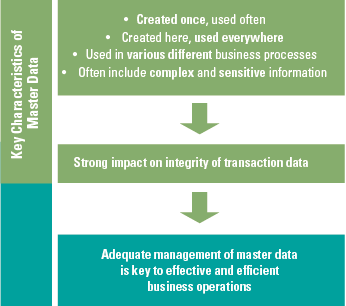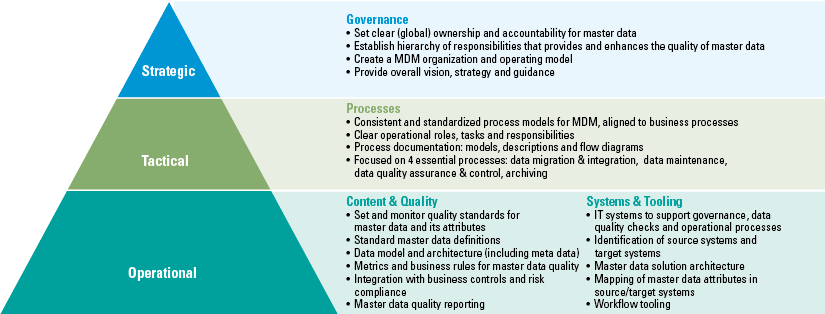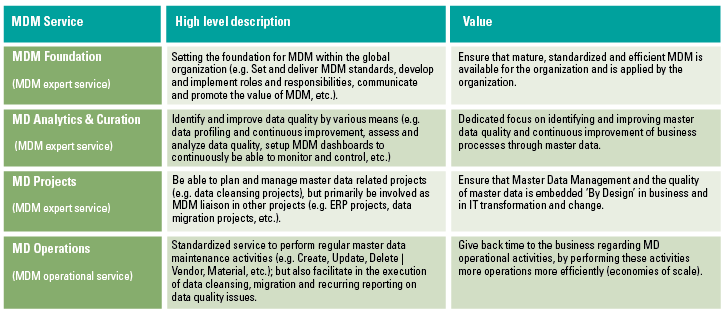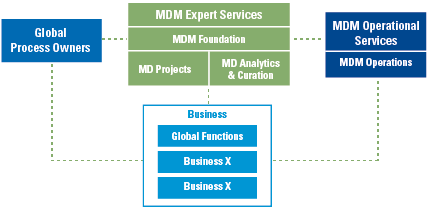Many organizations are on a journey to standardize and optimize their businesses in order to save costs and provide a better service to their customers. Master Data Management (MDM) should not be neglected on this journey. This article aims to convey the importance of master data management (MDM), to give practical guidance on how to service this as a global business service, and which prerequisites and pitfalls are relevant and need to be taken into account.
Introduction
Master data is basic business data that is used in common processes in each organization. Examples include the parties a company is doing business with (e.g. customers and vendors), locations where work is performed, or parts are stored (e.g. offices, warehouses) and the materials used or created during production processes (e.g. (raw) materials and products). Master data is everywhere and serves as the foundation for business processes.
To be able to successfully standardize or optimize business processes according to global standards, master data should be of high quality and conform to global data standards. For example, when working towards a centralized purchasing strategy, the master data within the source-to-pay process should be standardized, be consistent and of high quality to facilitate this. Managing this master data is therefore essential when organizations embark on this journey.
One of the means to facilitate the standardization and optimization of certain business processes is setting up Global Business Services (GBS) for MDM. GBS is a next-generation operational and organizational model that enables organizations to deliver business processes such as HR, finance, IT, and customer care to internal and external customers. It is often applied on a global scale using multiple service delivery models, including outsourcing, shared services and, increasingly, cloud solutions ([Brow16]).
Master Data Management
Master data
Defining master data is complex. Therefore, a simple guidance should give more clarity on what could be classified as master data. Figure 1 can be used to define your master data.
Figure 1. Characteristics of master data ([Jonk11]). [Click on the image for a larger image]
However, there is no universal view on what can be considered as master data. Master data is by nature complex, especially when data needs to be standardized throughout different businesses within an organization. Some examples:
- After the creation of master data, it runs through different parts of business processes (e.g. material master data is used in procurement, supply chain and finance);
- The complexity of business processes is often reflected in master data (e.g. multiple variants of the same procurement process results in a different setup of a vendor master or purchasing info records);
- Many definitions exist throughout the organization (e.g. no single definition to define a material).
Master data management
Master data, which is complex and greatly affects business processes, needs to be managed properly. This challenge becomes especially real when organizations are on a journey to centralize and globalize their business.
But is there really a need to centralize and standardize all master data? The answer is no, in the same way that it is not required that all data needs to be maintained centrally. Multiple factors influence the best organizational model for companies to govern their master data versus the maintenance of their master data.
To understand the concepts of this article, elaborating on master data management as a global service, the following principles should be taken into account:
- Data governance needs to be organized top down from a strategic level ([Unen12], [Staa17]). Meaning that classifying data as global and deciding on how it will be governed and maintained is a strategic decision;
- Data should always be owned by the business ([Jonk11], [Staa17]). Nevertheless, even if master data is governed centrally or even maintained centrally, ownership always remains within the business.
One part of master data management is to define which data to govern centrally or maintain centrally. More details on how to define these types of data and define the best organizational model is discussed in the article [Staa17] on organizing data management activities. Master data management is of course much broader. Master data management, in a nutshell, refers to all the processes, governance structures, content and quality of the data in place, including facilitating tooling and IT systems to ensure consistent and accurate source data for all business processes ([Jonk11]).
Figure 2. KPMG’s Master Data Management framework. [Click on the image for a larger image]
Global Business Services
The scope of Global Business Services within organizations is growing intensively. Where GBS are established to deliver, mainly operational, services; more and more organizations are implementing a global process owner structure within GBS, to facilitate or even enforce standardization and optimization within business processes. These so-called Expertise Centers are responsible for embedding these standard global business processes throughout the entire organization.
The ambition of organizations which are on the journey of centralization and standardization and even have the GBS capabilities in place, cannot neglect the importance of MDM. It is not only a necessity, but also an opportunity for GBS entities to deliver MDM as a service to the organization. Therefore, GBS is the perfect platform to enable best-in-class MDM throughout the entire organization ([Brow16]).
Master data management as a global business service
It is not necessary to centralize all MDM related activities to Global Business Services. To get started, the most relevant master data, which has the largest impact on global and standardized business processes, should first be identified. In a previous article [Staa17], we elaborated on defining which data should be centralized within a global data management function, or which data to ‘should be left to the business’. In this section we do not attempt to identify which data should or should not be centralized, but which services can be provided and how to organize Master Data Management as a global business service.
Master data services
Maintaining master data often constitutes a large portion of the work within a business; from the create, read, update and delete (CRUD) processes to mass changes, data cleansing and data migration. Especially when these activities are repetitive, they can be nominated to be performed by GBS. In turn GBS would deliver these standardized services in a service level agreement.
Besides these repetitive activities, GBS are increasingly positioned to provide Expert Services to facilitate and even enforce MDM standards, organize governance and even report on and manage and monitor data quality.
Global Business Services for Master Data can therefore be split into two types:
- MDM Expert Services fulfills a business partner role for MDM (e.g. MDM Demand Management), drives continuous improvement and provides MD(M) expertise and support to the Global Process Owners and the specific business;
- MDM Operational Services provides operational services (e.g. maintenance of master data, data quality checks and cleansing services), and ensures service agreements are in place and processes exist to manage requests, incidents and changes. It also ensures the performance of MD operational services in accordance with agreed targets.
A brief elaboration of these services and their value is given in Table 1.
Table 1. Master data services. [Click on the image for a larger image]
Master data services operating model
The operating model for Master Data Management is by design split into two categories: operational and expert services. These expert services need close alignment to the global business process owners to facilitate and advise on everything that is required with regard to MDM in their processes. Operational services, on the other hand, can be nearshored, offshored or outsourced to cost efficient countries, if the processes are mature enough. This directly impacts part of the quantitative business case for providing MDM as a service, because a business case for merely MDM is most often of a qualitative nature ([Staa13]). The main indicators to calculate the quantitative business case are:
- FTE reduction, giving back time (improving processes/performance) and focusing on first time right;
- eliminating business errors/disruptions due to incorrect master data;
- FTE to low cost countries by nearshoring, offshoring and outsourcing.
GBS is often hierarchically positioned as a staff function at the corporate level. Meaning that the mandate is often limited to providing services to and facilitating the business. The main challenge to transfer MDM services within GBS is interaction with the business and enforcing process and data standards in existing business processes. A simple example is using the same procurement principles (e.g. payment terms) throughout the organization.
Proper governance in defining GBS’ role and accountability towards master data is a prerequisite to be successful in this. When governance is not in place, MDM within GBS will fail. On the other hand, if the governance between GBS and the business is not in place for global process ownership, it will also fail.
Therefore, MDM should be organized in the same way as the global process ownership operating model within the organization.
Figure 3. MDM Services Operating Model. [Click on the image for a larger image]
The model in Figure 3 reflects the split between MDM Expert Services and MDM Operational Services. It is very important to detail how MDM within GBS can facilitate the global process owners and how it will deliver services to the business.
Prerequisites for success
To successfully implement and enforce standards within the organization, it is important to consider the following:
- Sponsorship at the C-level: in the executive committee there should be at least one member who is accountable and provides sponsorship for MDM. Getting things done on a global level is difficult and challenging and almost always requires assistance from the C-level;
- Awareness throughout the entire organization: ‘what’s in it for me?’ is the most frequently asked question in the business. Showing the impact with facts and figures is therefore a great way to create awareness. Involvement and support of local organizations is crucial and should not be underestimated;
- Facts and figures: simply stating that MDM is important, does not create a sense of urgency amongst employees. Though they generally understand this better than a much of the senior management. Showing facts and figures and as soon as possible creating data quality, process quality and business impact dashboards (related to master data errors) does and therefore is of great importance;
- Make use of existing MDM expertise in the organization: organizing MDM as a global business service does not mean you have to start from scratch. Organizations often already have global or semi-local data management offices and functions. The knowledge already resides in the business, so it is a prerequisite to use this expertise in the new organizational setup;
- Mature and organized GBS: a clearly defined process and governance of an existing GBS organization supporting its business is a prerequisite to be successful in MDM serviced from GBS.
Pitfalls and challenges
Although recognizing the above design principles and prerequisites to be successful, there are pitfalls that need to be taken into account. In KPMG’s experience the following pitfalls are most the important:
- Change management: implementing MDM as a global business service will affect people. Not only will the organization structure change, but people’s jobs will also change. Especially when nearshoring, offshoring or outsourcing activities to low cost countries, jobs will be lost on-shore. Since people in their current positions fulfill an important role during transition activities, an effective change management strategy needs to be in place;
- Ownership and leadership: clear ownership and leadership also needs to be in place during the pre-stages of the setup of MDM within GBS. Not only to facilitate and hold discussions but also to setup a proper landing organization;
- Lift and shift versus fix and shift: standardized, well documented and efficient processes are easy to transfer to other parties inside and outside the organization. It is often the case that this is not in place. There are multiple strategies that define what to do when to-be transferred processes are not of sufficient maturity, or simply when tacit knowledge is of major importance in execution, and this cannot be standardized or documented. The dilemma is to choose between ‘lift and shift’ (transfer processes as-is) or ‘fix and shift’ (optimize processes before transferring). ‘Lift and shift’ gives a clear scope and the ability to fix during or after the transfer. ‘Fix and shift’ delays the process of transition and does not take global standards into account. This means you often have to apply a fix again after the transfer is complete;
- Focus on both qualitative and quantitative benefits: of course cost reduction is one of the tangible goals of a GBS organization, in moving activities to low cost countries. This is a large part of the quantitative business case for MDM as a global business service. But really the main business case is qualitative. Being able to standardize and deliver expertise services to help the organization to improve, adds far more value;
- Too optimistic in near/offshoring and outsourcing opportunities: the connection and relation to the business (end-users) is key in MDM. You are servicing the business in managing their data properly. You have to take into account the quality of the service provided by a near/offshore or outsource location. The distance to the business is potentially much greater, as well as the business knowledge needed to perform certain activities. Especially when MDM is not yet mature, transferring these activities to low cost countries before a proper transition is in place, is a large risk for success. This will affect part of the quantitative business case, but from a qualitative perspective it makes sense to optimize first before using near/offshoring or outsourcing options;
- Formalize the service model and accompanying service levels: delivering services needs to be formalized with regard to accountability and responsibility. Two primary questions are relevant here:
- Who is going to pay for the service and how are prices set?
- How can the quality of the service be guaranteed?
Both questions should be answered in a formalized service model with accompanying service levels on both the processing time and the quality of the work. The service model should define the mutual accountabilities in delivering the service.
Conclusion
MDM is a prerequisite for an organization’s journey towards standardization and optimization of their business. It is a major opportunity to approach MDM from a global perspective to facilitate this journey. Setting up MDM as a global business service is therefore a good strategy to choose. In this article we have seen that there are important prerequisites to be successful, and multiple pitfalls to be overcome when servicing MDM. But when organized properly, MDM as a global business service is something that all organizations striving towards standardizing and optimization of their business should think about.
References
[Brow16] David J. Brown and Stan Lepeak, Master data management. A critical component of Global Business Services for improved decision-making KPMG, 2016.
[Jonk11] R.A. Jonker, F.T. Kooistra, D. Cepariu, J. van Etten and S. Swartjes, Effective Master Data Management, Compact 2011/0.
[Staa13] A.J. van der Staaij MSc RE, M.A. Voorhout MSc and S. Swartjes MSc Master data management: From frustration to a comprehensive approach, Compact 2013/3.
[Staa17] A.J. van der Staaij MSc RE and drs. J.A.C. Tegelaar, Data management activities, Compact 2017/1.







